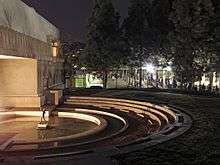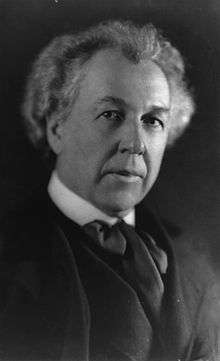Hollyhock House
|
Aline Barnsdall Complex | |
|
the Hollyhock House | |
   | |
| Location | 4800 Hollywood Boulevard, Los Angeles, California, United States |
|---|---|
| Coordinates | 34°05′59.85″N 118°17′40.61″W / 34.0999583°N 118.2946139°WCoordinates: 34°05′59.85″N 118°17′40.61″W / 34.0999583°N 118.2946139°W |
| Built | 1922 |
| Architect | Frank Lloyd Wright |
| Architectural style | Mayan Revival architecture |
| NRHP Reference # | 71000143 |
| LAHCM # | 12 |
| Significant dates | |
| Added to NRHP | May 06, 1971[1] |
| Designated NHL | April 04, 2007[2] |
| Designated LAHCM | 01 Apr 1963[3] |
The Aline Barnsdall Hollyhock House is a building in the East Hollywood neighborhood of Los Angeles, California, originally designed by Frank Lloyd Wright as a residence for oil heiress Aline Barnsdall, built in 1919–1921. The building is now the centerpiece of the city's Barnsdall Art Park.
History
Barnsdall originally intended the house to be part of an arts and theater complex on a property known as Olive Hill, but the larger project was never completed.[4] This was Wright's second project in California, and, atypically for Wright, he was not able to personally supervise much of the construction due to his preoccupation with designing the Imperial Hotel in Japan at the time. He delegated many of the responsibilities involved in designing the house to his assistant, Rudolph Schindler, and his son, Lloyd Wright.
Disillusioned by the costs of construction and maintenance, Barnsdall donated the house to the city of Los Angeles in 1927 under the stipulation that a fifteen-year lease be given to the California Art Club for its headquarters, which it maintained until 1942. The house has been used as an art gallery and as a United Service Organizations (USO) facility over the years. Beginning in 1974, the city sponsored a series of restorations, but the structure was damaged in the 1994 Northridge earthquake. It was again restored, and was open to the public as of June 2005.
The U.S. Department of the Interior designated Hollyhock House a National Historic Landmark in 2007.[5] It was the seventh site in the city of Los Angeles to receive that designation.
In 2008, the U.S. National Park Service submitted the Hollyhock House along with nine other Frank Lloyd Wright properties to a tentative list for designation as World Heritage Site. The ten sites were submitted as one total site.[6]
The house was included in a list of all time "top ten" Los Angeles houses in a Los Angeles Times survey of experts in December 2008.[7]

In January 2015 it was announced on the official site that, following extensive renovations, the house would once again open for tours on 13 February.[8] The 24-hour event drew large crowds through the night, with many waiting in line for over three hours for admittance.[9]
Features

As with many of Wright's residences, it has an "introverted" exterior with small windows, and is not easy to decode from the outside. The house is arranged around a central courtyard with one side open to form a kind of theatrical stage (never used as such), and a complex system of split levels, steps and roof terraces around that courtyard. The design features exterior walls that are tilted back at 85 degrees (which helps provide a "Mayan" appearance sometimes referred to as the Mayan Revival style), leaded art glass in the windows, a grand fireplace with a large abstract bas-relief, and a moat. Water is meant to flow from a pool in the courtyard through an underground tunnel to this inside moat, and out again to a fountain.
The front doors are stepped similarly to the entryway. The split doors rest on pins and swing open easily despite their massive weight. The keyhole is concealed with a decorative flap.
The hollyhock is used as a central theme to the house, with many symmetrical decorations adapting the plant's general appearance. Planters are decorated with the motif and filled with the plants themselves, and Wright's stained glass windows feature a highly stylized hollyhock pattern. An interesting feature is the glass corners, an early Wright idea later used at Fallingwater.
Hollyhock House features an entertainment room immediately to the right of the entrance. This room contains possibly the first built-in entertainment center, complete with LP-sized cabinets along the floor. Other notable rooms include a child's play area as well as a modernist kitchen, which long housed the museum gift shop.
Like many houses designed by Wright, it proved to be better as an aesthetic work than as a livable dwelling. Water tended to flow over the central lawn and into the living room, and the flat roof terraces were conceived without an understanding of Los Angeles' rains. The cantilevered concrete also has not stood up well to the area's earthquakes.
There were a considerable number of revisions. Two smaller structures, called Studio Residence A and B, were built on the grounds. Residence A still stands. The client also commissioned a private kindergarten which was never built.
Use in film production
The house and grounds were used as the temple of the Piranha Women in 1989's Cannibal Women in the Avocado Jungle of Death.
Friends of Hollyhock House (FOHH)
The FOHH provide an increased public awareness of Frank Lloyd Wright, Aline Barnsdall, and Hollyhock House through public tours, special events, and the Friends of Hollyhock House Library. The library is a small research library that contains books and articles on Frank Lloyd Wright and Aline Barnsdall. All docents are members of the Friends of Hollyhock House.
Gallery
- Tunnel-like entrance with hollyhock carvings
- Hollyhock carvings decorate this exterior planter
- View over the pool, with the central courtyard and living room beyond
- Wright's glass designs recall the hollyhock theme; note the glass corner
.jpg) Exterior view of the Hollyhock House, Los Angeles, 1921
Exterior view of the Hollyhock House, Los Angeles, 1921.jpg) Exterior view of the Hollyhock House, Los Angeles, 1921
Exterior view of the Hollyhock House, Los Angeles, 1921.jpg) Exterior view of the Hollyhock House, Los Angeles, 1921
Exterior view of the Hollyhock House, Los Angeles, 1921.jpg) Exterior view of the Hollyhock House, Los Angeles, 1921
Exterior view of the Hollyhock House, Los Angeles, 1921.jpg) Exterior view of the Hollyhock House, Los Angeles, 1921
Exterior view of the Hollyhock House, Los Angeles, 1921.jpg) Exterior view of the Hollyhock House, Los Angeles, 1921
Exterior view of the Hollyhock House, Los Angeles, 1921
See also
- Los Angeles Historic-Cultural Monuments in Hollywood
- List of Registered Historic Places in Los Angeles
- Storer House
- California Art Club
- Ennis House
References
- ↑ National Park Service (2007-01-23). "National Register Information System". National Register of Historic Places. National Park Service.
- ↑ "Aline Barnsdall Complex". National Historic Landmark summary listing. National Park Service. Retrieved 2007-10-09.
- ↑ Department of City Planning. "Designated Historic-Cultural Monuments". City of Los Angeles. Retrieved 2010-06-15.
- ↑ Friedman, Alice T. (2006). Women and the Making of the Modern House, p. 35. Yale University Press.
- ↑ "Interior Secretary Kempthorne Designates 12 National Historic Landmarks in 10 States". U.S. Department of the Interior. Archived from the original on 2007-10-27. Retrieved 2008-05-12.
- ↑ "New US World Heritage Tentative List". Nps.gov. Retrieved 2012-08-15.
- ↑ Mitchell, Sean (December 27, 2008). "The best houses of all time in L.A.". Los Angeles Times. Retrieved 2008-12-27.
- ↑ Boone, Lisa (February 6, 2015) "Frank Lloyd Wright's Hollyhock House to reopen" Los Angeles Times
- ↑ Lelyveld, Nita (2015-02-14). "At Hollyhock House, thousands celebrate an architectural treasure". Los Angeles Times. Archived from the original on 2015-02-15.
External links
| Wikimedia Commons has media related to Hollyhock House. |
